Smoking a turkey is a great way to infuse it with flavor and make it extra juicy. If you’ve never smoked a turkey before, though, it can seem like a daunting task, so we are here to show you how to season and smoke a turkey for the most mouthwatering turkey you’ve ever had.
The key to a great smoked turkey is in the seasoning. A well-seasoned bird will have flavorful, crispy skin and juicy, tender meat.
With this guide, we’ll walk you through everything you need to know to season and smoke a turkey perfectly so you have that perfect smoked turkey breast or leg for dinner!
You may be reading this during the holidays when everybody is cooking their turkeys, but looking past Thanksgiving and Christmas, a smoked whole turkey is a great meal any time. No special occasion is needed. It will certainly work for your Thanksgiving turkey, but also for that 3rd Saturday in May turkey as well!
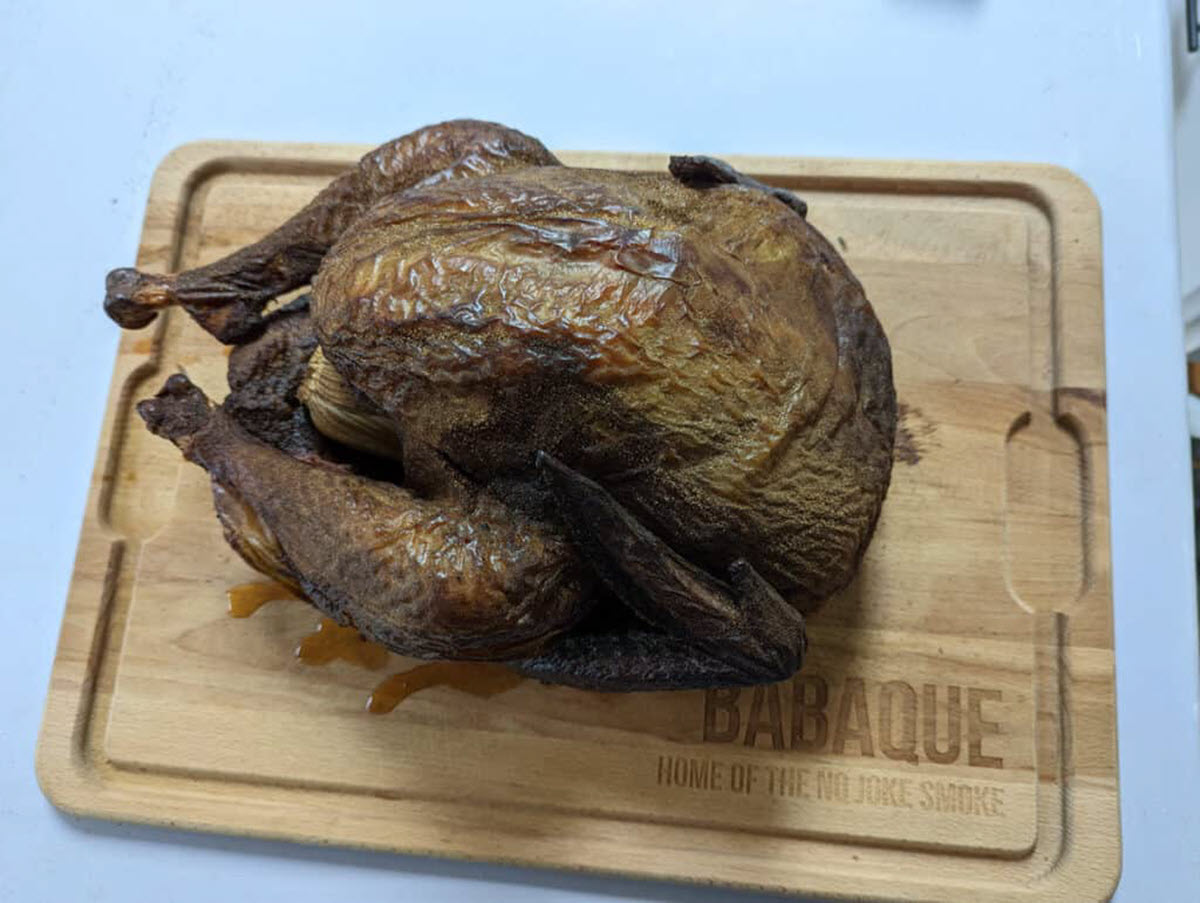
The amount of time and effort put into your smoked turkey, though, means you’ll want to make sure it’s all done in a way that ensures the mouthwatering, juicy, smoky turkey you expect.
Brining your turkey before smoking it
If you’re looking to take your turkey smoking game up a notch this year, look no further than brining. Brining is a process of marinating the turkey in a solution of water, salt, and other seasonings (like herbs and spices) prior to smoking. This process helps to flavor the meat and keep it moist during the cooking process.
So, how do you go about brining a turkey? Below, we’ll walk you through everything you need to know about brining a turkey for smoking, from what type of salt to use to how long to let the bird soak. By the time you’re finished reading this, you’ll be an expert!
This process will help to tenderize the meat and infuse it with flavor. With just a few simple steps, you can have a delicious smoked turkey that will be the star of your holiday meal.
What is Brining?
Brining is the process of marinating the turkey in a saltwater solution. This helps to tenderize the meat and infuse it with flavor and moisture, which will help keep it from drying out during cooking.
Brine solutions are key for smoking leaner meats like turkey breast. Without brining, your bird is more likely to dry out during the cooking process.
You will need to plan ahead when brining a turkey, as it needs to soak for at least 12 hours and preferably up to 24.
What You’ll Need for Turkey Brining
Before we dive into the nitty-gritty of how to brine a turkey, let’s first go over what you’ll need. For the actual brine solution, you’ll need:
- 1 cup of kosher salt (more on that later!)
- 1 cup of light brown sugar
- 1 gallon of filtered water
- 2 tablespoons of chopped fresh rosemary
- 2 tablespoons of chopped fresh thyme
- 1 tablespoon of chopped fresh sage
- 1 whole orange, cut into quarters
- 1 whole lemon, cut into quarters
- 1 head of garlic, halved crosswise
- 1 turkey 🙂
- A large stockpot or plastic container that can hold all of your ingredients (and fits in your fridge)
Other things to add to the brine based on your preferences:
- Dried thyme
- Black peppercorns
- Bay leaf
Below is an image you can download and print, hang on your fridge, etc.

Before you begin, make sure that your turkey is thawed. If it is still frozen, it will not absorb the flavors of the brine properly. We prefer not to start the brining with a frozen turkey, but if yours is frozen, I say brine it, let it sit on the counter for a while until the turkey thaws a bit, then put it in the fridge.
To make the brine, combine all of the ingredients in a large pot or pan and stir until the salt and sugar have dissolved.
Once everything is combined, add the turkey to the mixture and make sure that it is fully submerged.
If necessary, you can weigh down the turkey with a plate or bowl so that it stays under the surface of the liquid. Allow the turkey to brine for at least 12 hours or up to 24 hours for extra flavor.
When you are ready to cook the turkey, remove it from the brine and rinse it off with cold water. Pat it dry with paper towels, and then proceed with your recipe as desired. If you need some ideas for recipes or really anything else to do with smoking turkey or other meats, take a look at our review of the best cookbooks for smoking.
Be sure to discard the brine solution after you remove the turkey. It will be full of raw poultry juices and could contain harmful bacteria, so resist the urge to use the brine for anything else.
Brining needn’t be complex; I have brined whole turkeys by soaking in buttermilk in the fridge for 48 hours, and the result is wonderful!
By following these simple steps, you can easily brine a turkey for smoking and ensure it turns out juicy and flavorful every time. This process will help to tenderize the meat and infuse it with flavor, resulting in a delicious smoked turkey that will be the star of your holiday meal.
Now that we have all of our ingredients gathered, let’s move on to…
Seasoning your turkey before smoking it
Seasoning the turkey prior to smoking is the easy part once you decide on the type of rub you’ll use and if you will or won’t inject the turkey.
The best way to season a turkey for smoking is to use a dry rub. This will help the smoke flavor to penetrate the meat, and it will also give the skin a nice crispy texture. To make a dry rub, simply combine your favorite spices in a bowl and rub them all over the turkey.
You can keep it simple with salt, pepper, and garlic rub. This is a very basic rub that works well and is quick and easy. It’s my go-to.
Or you can get a bit more adventurous with a more complicated rub. Some good spices to use include paprika, garlic powder, onion powder, black pepper, and cumin. Once you’ve rubbed the spices into the skin, let the turkey sit for at least an hour so that the flavors can fully develop.
Here are some other ingredients you should consider, based on your own taste and whoever else is going to be enjoying your turkey:
- Paprika
- Salt flakes
- Mustard powder
- Garlic powder
- Onion powder
- Parsley
- Brown sugar
- Sage
- Rosemary
- Ground black pepper
- Cayenne pepper
- Thyme
- Ground cumin
- Chili powder
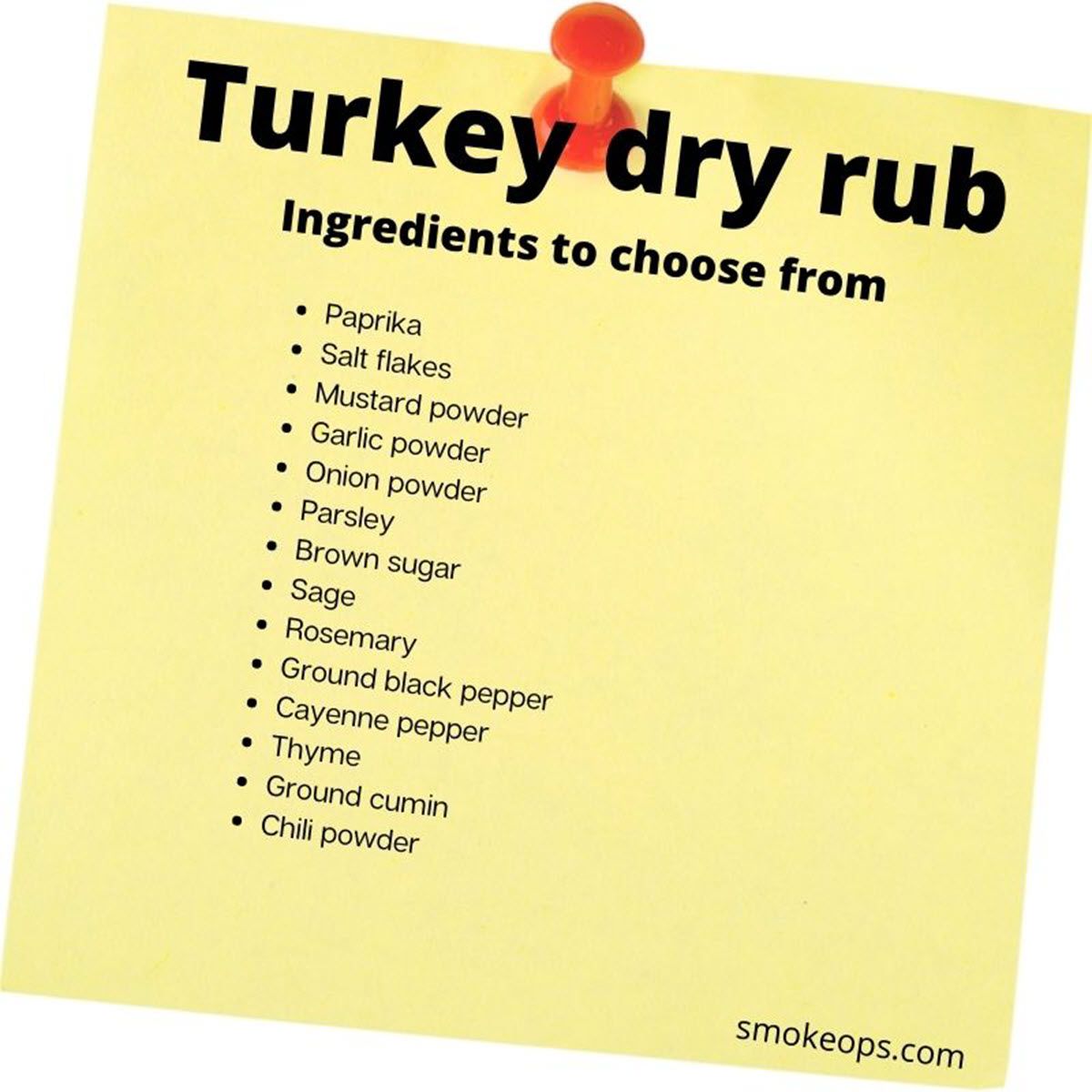
If you want, you can also inject your turkey with a marinade before smoking it. This is completely optional, but if you do choose to inject your turkey, use an injector that is made for the task, not a standard syringe or another tool. Here’s the one I use, but any will do.
Keep the injection points toward to top of the turkey based on how you will be cooking it to prevent juices from running out while cooking. So orient the turkey however it will be when in the smoker, and inject your marinade from the top portions.
To inject your turkey, simply mix together your favorite marinade ingredients and slowly inject them into the meat using a back-and-forth motion. again, let the turkey sit for at least an hour before smoking it so the injected juice can spread throughout the turkey.
There are a lot of different marinades to consider for your turkey.
Store-bought marinades are quite good and great if you are just starting out or perhaps are a bit pressed for time.
Alternatives to store-bought marinades are limited only by your own creativity. Here’s a quick list to get your creative juices (pun intended) flowing:
- A simple mixture of garlic, butter, and herbs
- A spicy Cajun marinade with cayenne pepper, paprika, and garlic powder
- A fruity marinade made with orange juice, cranberry juice, and rosemary
- A chipotle pepper and adobo sauce mixture
- A basic apple cider vinegar and water mixture
- Garlic, herb, and wine mixture
- Honey, soy sauce, and ginger mixture
- Barbecue sauce
- Apple cider
- Beer
- Root beer
- Lemon, butter, and herbs
- Chicken broth
- Olive oil
- Apple cider vinegar
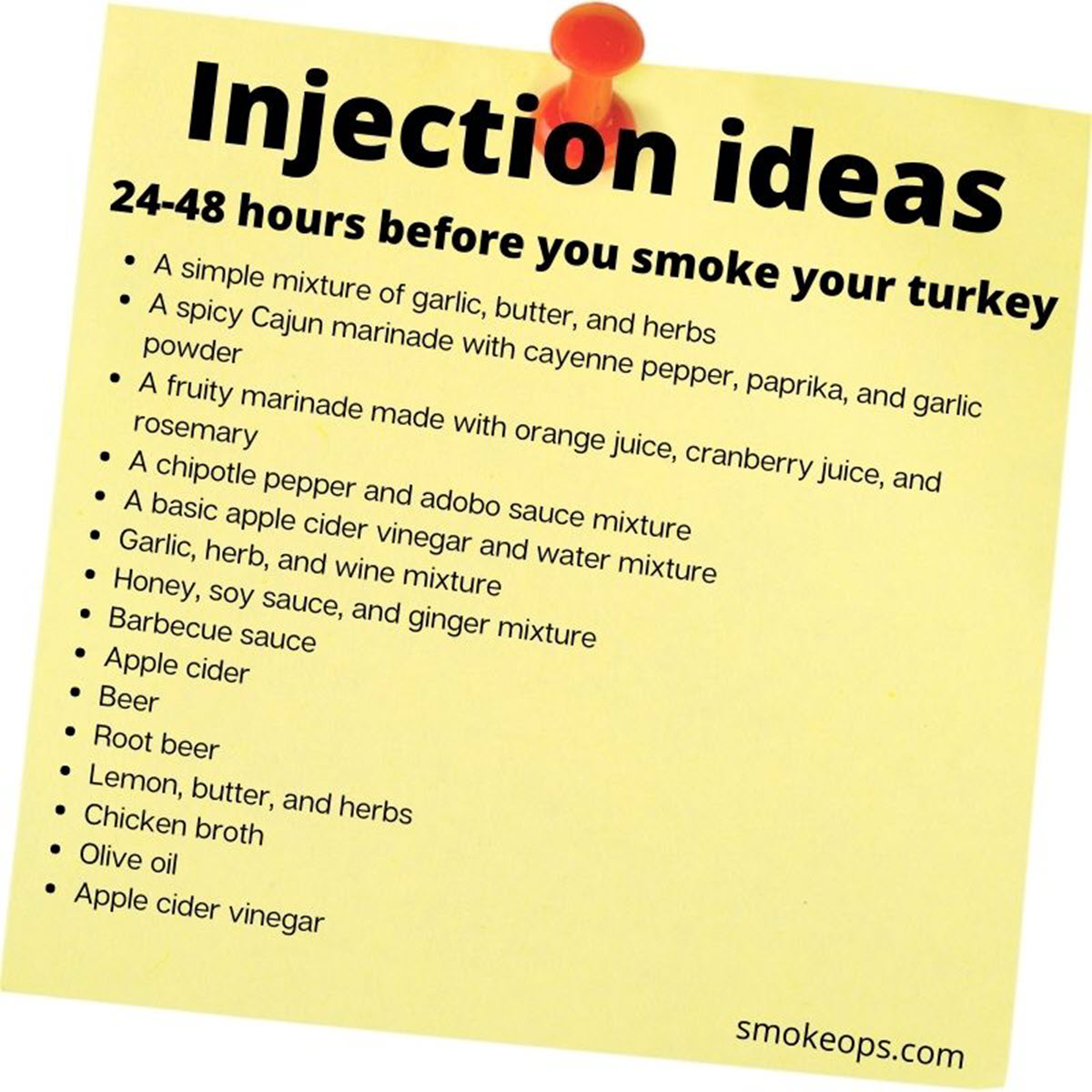
Now that we’ve brined, marinaded, and seasoned our turkey, it’s time to move on to…
Stuffing your turkey before smoking it
There is much debate about smoking a stuffed turkey. Should you or shouldn’t you?
The concern is around the bacteria and germs that can live and form in a turkey if it doesn’t get past that 140F degree mark quickly enough, and filling the turkey cavity with a lot of stuffed foods will cause the turkey itself to take longer to heat up and cook.
It’s a viable concern. You do not want to prolong that turkey getting past that important 140F temperature mark.
Some people will cook the stuffing separately, so it’s already hot when it’s added to the turkey. This is a good idea and still allows the stuffing to benefit from the smoke.
Many will say that if you stuff the turkey with raw stuffing, the turkey will get done, but the stuffing will not. But if you stuff the turkey with cooked stuffing, the stuffing will be burnt by the time the turkey is done. There must be some middle ground.
The safe alternative is to cook them separately. Feel free to “stuff” the turkey after cooking for dramatic effect.
If you choose not to stuff the turkey with…stuffing…at least consider putting some flavor enhancers in the cavity of the turkey. Onions, garlic, apples, etc…stuff that doesn’t actually need to cook but will give off extra flavor while the turkey is cooking. You’ll want to discard these items afterward as they will have absorbed much of the turkey juice, which, we know by now, can be harmful if not appropriately cooked.
Whatever method you choose, be mindful of how the stuffing will affect the cooking time of the turkey.
Here are a few popular examples of stuffing for smoked turkeys:
- Sausage, fresh herbs, sautéed vegetables, fresh herbs, bread, and tart apples
- Seasoned Breadcrumbs, sausage, sautéed mixture, butter, egg, fresh Rosemary, fresh Thyme, fresh Sage, chicken broth
- Apples, pecans, onions
- Bread cubes, apple, almonds, green onion, apple juice, butter, and thyme
Preparing the smoker for your turkey
Ok, you have prepared the turkey for the smoker; now we must prepare the smoker for the turkey.
The main consideration here is the type of fuel you’ll be using. For the most part, you have the choice of stick, lump charcoal, wood chunks, or pellets. Oh, or gas. You may also be working with a standard charcoal grill, an offset smoker, a vertical smoker, or perhaps even a custom or homemade setup. All of these approaches work fine. In my yard, I have a Z-Grills pellet smoker and an upright Oklahoma Joe’s smoker. I bought this Z-Grills pellet smoker on a whim, and I have to say, I enjoy it!
…and below is a picture of the big boy. I now use the Z-Grills smoker for smaller, ad-hoc, and even daily cooking. I open up the OK Joe’s when I need to cook for everybody.
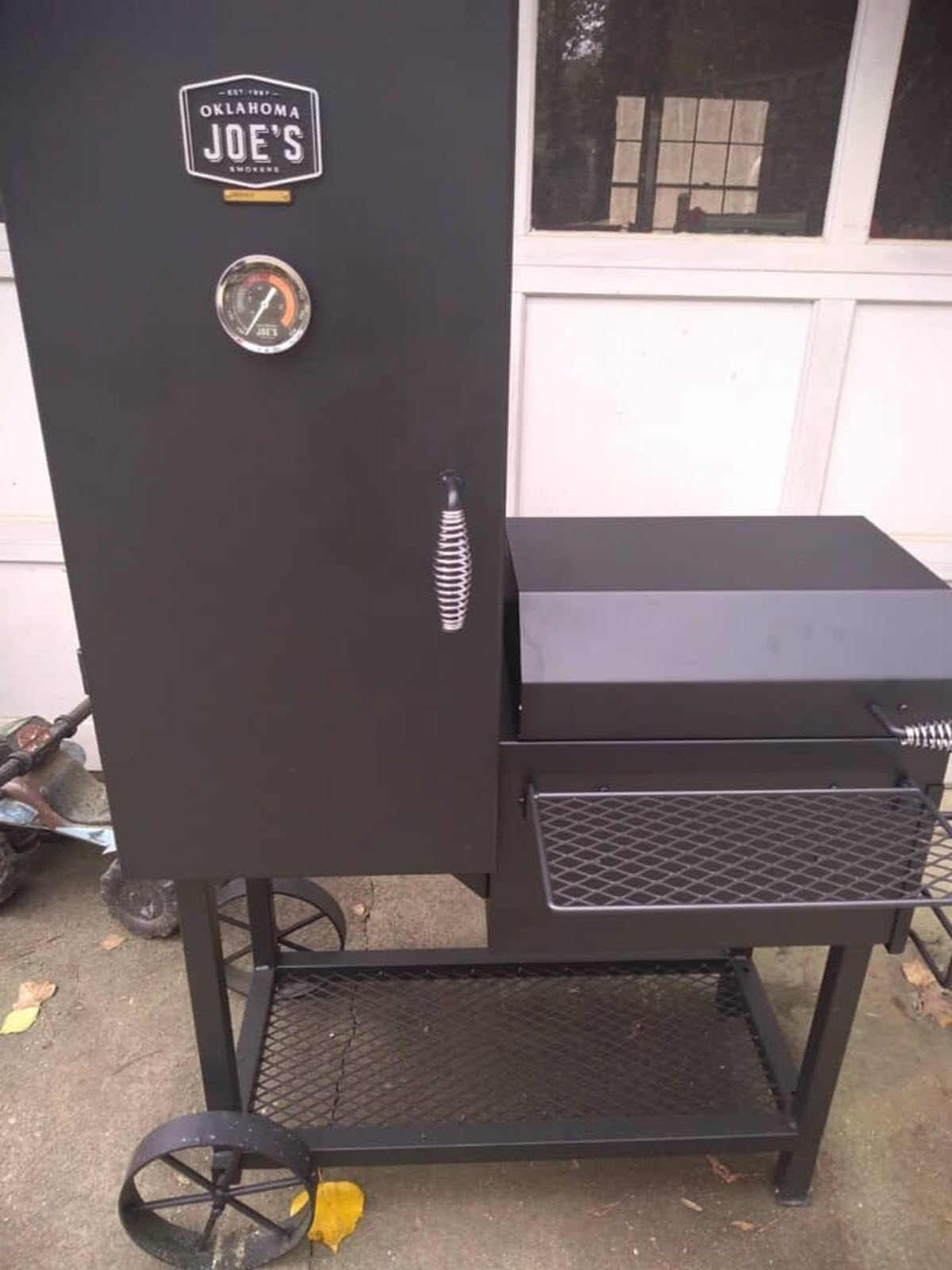
Types of wood or smoke for your smoked turkey:
For Turkey, you’ll generally want to opt for less of a “steak” or “brisket” type of smoke and for more of a smoke that is on the sweet or fruity side.
When smoking a turkey, the turkey will absorb more of the color and flavor of the smoke than a piece of beef or pork will. For this reason, we usually want to use a lighter touch with the smoke.
- Cherry: This is my favorite for smoked turkey and, in fact, just about anything. Cherry smoke pairs well with just about everything you want to smoke and is a safe smoke to choose if this is your first smoked turkey. It imparts great flavor but can be overpowering, so go easy with it.
- Pecan: With a nutty and sweet flavor, pecan pairs with poultry quite well and is a very good choice for your smoked turkey
- Apple: As with pecan, apple brings a sweet, fruity, somewhat mild smoke and also works wonderfully with turkey
- Alder: Less common, but if you can find it, it’s a great all-around smoking wood and goes well with just about anything, including turkey.
- Maple: My explanation of maple smoke is pretty much the same as for apple – mild, sweet, fruity, and yep, it works well with turkey.
- Hickory: Probably one of the most common smokes and has a strong, spicy and smokey flavor. This is universally used for smoking beef and pork. It is generally considered to be too heavy to use for turkey or other poultry. It doesn’t mean you can’t try it, though, but go easy on it.
- Oak: Similar to hickory, but less severe. It’s milder than hickory but stronger than the fruit smoke mentioned above. Oak can be used literally on anything you want to smoke, including turkey. Most bags of “generic” lump charcoal you’ll buy are oak, and it will give off great smoke.
- Mesquite: This is the king of smoke and gives you the boldest, strongest smoke of all of them. Usually used only for bold smoke flavor on beef and pork, it is seldom used for turkey as it can easily overpower the taste of the turkey itself.
- Mix them up! Mix up some pecan and apple for your smoked turkey. Great idea!
I have taken to adding additional smoke to my cook by using a smoke tube in my pellet grill to ensure I get a good amount of smoke. I’m a bit skeptical of the overall smokeability of pellets at the moment.
In addition to the smoke you’ll be using, you need to determine ahead of time what temperature you’ll be smoking the turkey at. Here is where you’ll find a bazillion different suggestions and opinions.
In my opinion, there is no more trusted source when talking turkey than Butterball. Growing up, it was always “Butterball turkey this” or “Butterball turkey that.” So, let’s see what they have to say about how long a turkey should smoke, and at what temperature.
Butterball’s advice with regard to temperature and cook time aligns with the standard advice you’ll see elsewhere insofar as getting your turkey out of the danger zone.
Turkey must pass through the 40F -140F range in less than 4 hours.
If it takes longer than this, your turkey can actually become a place where dangerous germs can grow. Even the CDC mentions it, so it must be true! For some reason, the CDC is inextricably linked to zombies for me, so I can only assume undercooking your turkey has a good chance of causing the apocalypse. You don’t want to be responsible for that.
Fortunately, unless your turkey is ginormously huge, getting it above 140F in 4 hours is pretty easy with a cooking temperature of 225F or higher. And I don’t know of anybody recommending a cooking temperature of less than 225F for a turkey. Most often, you’ll want your temperature to be around 275, maybe 300 for your smoked turkey.
So it really becomes a question of how fast you want to cook it. “Low and slow” at around 225 to ensure it absorbs as much smoke as possible? Or faster at around 350F to ensure it doesn’t dry out?
Smoking your turkey
The night before you plan to smoke the turkey, remove it from the fridge and allow it to come to room temperature. This will help the meat cook evenly. Next, mix together your spices to create a rub. Rub this mixture all over the turkey, getting into all of the nooks and crannies. Once the turkey is well-coated, wrap it tightly in plastic wrap and refrigerate overnight.
You’ll be flying blind without a good meat thermometer. Do not rely on your grill/smoker’s temp gauge, and do not rely on any pop-up indicator on the turkey itself. A good meat thermometer will improve your grilling/smoking immensely and should be considered as a cost (small cost, actually!!) of doing business. Go buy one if you don’t have one. You can get a great one for less than $50. I use two separate ones when I’m cooking, two different brands, to ensure my temps are as accurate as possible. I also have a third one which is a switchblade type of instant thermometer. It’s that important. I have smoked meat without a meat thermometer, but never as successfully as when I use one.
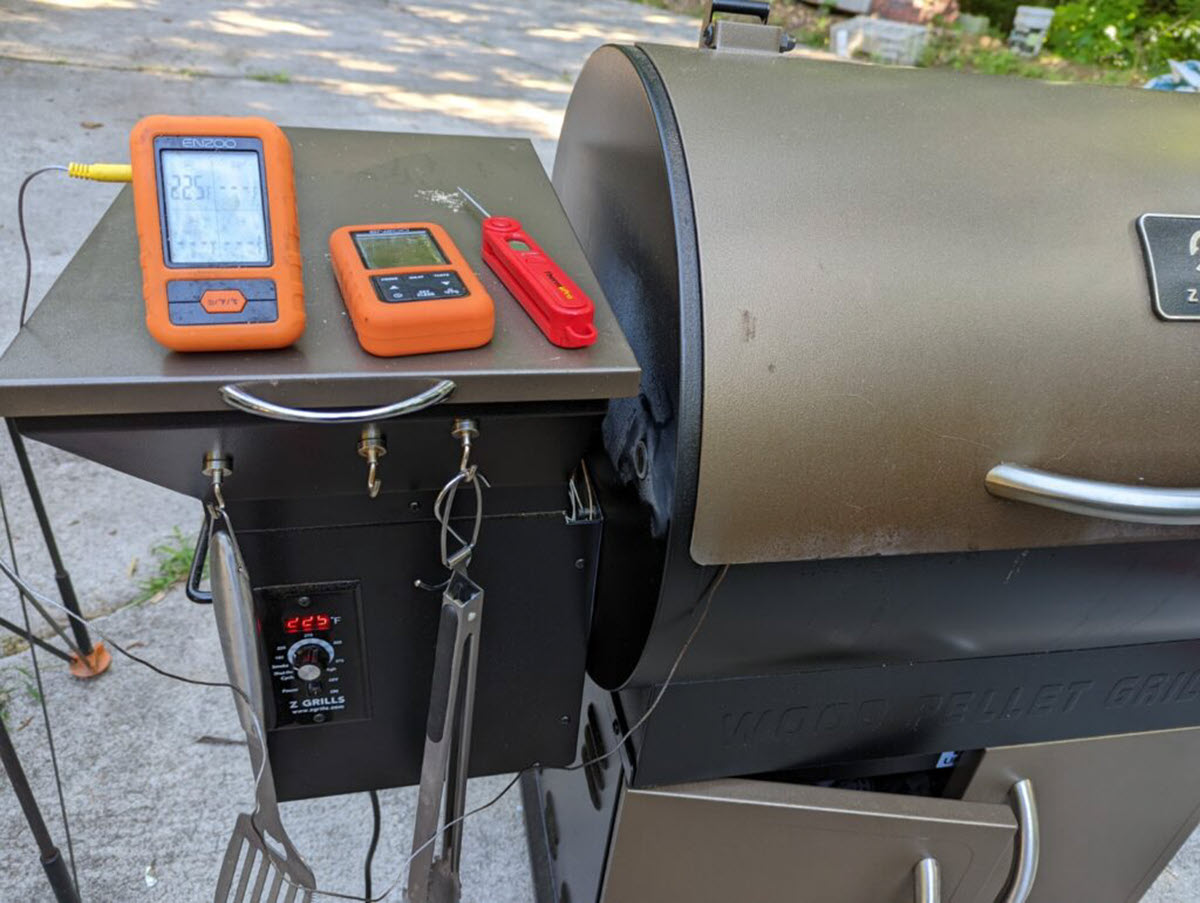
How long should I smoke the turkey?
When you’re ready to cook the turkey, Preheat your smoker to 275 degrees Fahrenheit. Place the turkey on the rack inside the smoker and cook for 3-4 hours, or until the internal temperature of the turkey meat reaches 165 degrees Fahrenheit. You want to take this temperature at the thickest meaty parts, so usually the thigh and the breast. Make sure your temperature probe is not touching a bone as that will through off your readings. Baste the turkey every hour or so with some of its own juices to keep it moist.
We often hear questions like “how long to smoke a turkey at 225” or “how long to smoke a turkey at 275”. These are tough questions to answer as they don’t indicate how large the turkey is. The only thing we can really say is that it’ll take longer at 225 than it will at 275, but we can’t really offer a definitive timeline. Expect 3-4 hours
- Start with a quality turkey. Buy a fresh or frozen bird that is 12 pounds or less. Anything larger will be difficult to cook evenly.
- Thaw the turkey completely if it is frozen. This can take up to two days in the refrigerator.
- When you’re ready to season the turkey, first rinse it inside and out with cold water. Then, pat it dry with paper towels.
- To make a flavorful rub, mix together two tablespoons each of salt, paprika, and garlic powder. Add one tablespoon of black pepper and one teaspoon of dried thyme leaves. Rub this mixture all over the outside of the turkey, getting under the skin as well as on top of it.
- Place the turkey on a rack in a roasting pan, breast side up. If you like, you can stuff the cavity with aromatic vegetables like onions, celery, and garlic cloves.
- Roast the turkey in an oven set to 325 degrees Fahrenheit until the internal temperature of the thickest part of the thigh reaches 165 degrees Fahrenheit. This will take approximately 3-4 hours for a 12-pound turkey.
- While the turkey is roasting, prepare your smoker according to the manufacturer’s instructions. When it’s ready, set the temperature to 225 degrees Fahrenheit.
- When the turkey is done roasting, transfer it carefully to the smoker using tongs or two large spatulas. Smoke for 1-2 hours until the skin is crisp and caramelized and the meat is cooked through.
- Let the smoked turkey rest for 20-30 minutes before carving to allow juices to redistribute throughout the meat. Serve hot with your favorite holiday side dishes!
When you’re done smoking your turkey
Once it’s done cooking, there are only 2 very important steps to follow:
- Let the turkey rest for at least 30-45 minutes, maybe an hour, if you can keep everybody’s fingers out of it.
- Eat and enjoy!
One thing to note is that pink turkey meat is ok as long as you know the internal temperature got to 165F. Smoked turkey meat is often pinkish so keep that in mind. After smoking a turkey, ping meat does not necessarily mean it’s underdone.
Smoked turkey – wrapping it up
Smoking a turkey is a great way to infuse it with flavor and make it extra juicy. With this guide, we’ve walked you through everything you need to know to season and smoke a turkey perfectly. By following these simple steps, you’ll be able to impress your guests with a delicious smoked turkey that’s packed with flavor.
